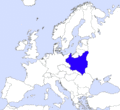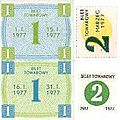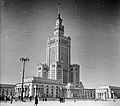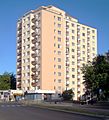Polish People's Republic facts for kids
The Polish People's Republic was the official name for Poland from 1952 to 1989. During this time, Poland was a satellite state of the Soviet Union. This meant the Soviet Union had a lot of influence over Poland's government and daily life.
Quick facts for kids
Republic of Poland (1944–52)
Rzeczpospolita Polska Polish People's Republic (1952–89) Polska Rzeczpospolita Ludowa
|
|||||||||||||
|---|---|---|---|---|---|---|---|---|---|---|---|---|---|
| 1944–1989 | |||||||||||||
|
|
|||||||||||||
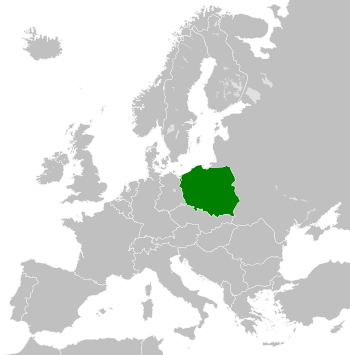
Location of the People's Republic of Poland in Europe.
|
|||||||||||||
| Status | Satellite state of the Soviet Union Member of the Warsaw Pact |
||||||||||||
| Capital | Warsaw Lublin (1944–45) Łódź (1945–48) |
||||||||||||
| Common languages | Polish | ||||||||||||
| Government | Marxist–Leninist single-party state (after 1952) | ||||||||||||
| Head of State | |||||||||||||
|
• President
1944–1952 |
Bolesław Bierut (first) |
||||||||||||
|
• 1989
|
Wojciech Jaruzelski (last) | ||||||||||||
|
• Chairman of the Council of State
1952–1964 |
Aleksander Zawadzki (first) |
||||||||||||
| Prime Minister | |||||||||||||
|
• 1944–1947
|
Edward Osóbka-Morawski (first) | ||||||||||||
|
• 1989
|
Tadeusz Mazowiecki (last) | ||||||||||||
| Historical era | World War II, Cold War | ||||||||||||
| 1944 | |||||||||||||
|
• Workers' Party established
|
December 16–21, 1948 | ||||||||||||
|
• Constitution
|
July 22, 1952 | ||||||||||||
|
• Democracy restored
|
December 30 1989 | ||||||||||||
| Area | |||||||||||||
| 1990 | 312,685 km2 (120,728 sq mi) | ||||||||||||
| Population | |||||||||||||
|
• 1946
|
23930000 | ||||||||||||
|
• 1990
|
37970155 | ||||||||||||
| Currency | Polish złoty | ||||||||||||
| ISO 3166 code | PL | ||||||||||||
|
|||||||||||||
Contents
Poland's History as a People's Republic
How Poland Got Its Name
The name "People's Republic of Poland" was first suggested in a draft of the country's constitution. This plan was created by Bolesław Bierut, who was a key leader at the time. The idea for the name came from the Soviet leader Joseph Stalin. He even made changes to the draft constitution himself.
Challenges with the Catholic Church
The Polish government generally allowed people to have religious beliefs. However, in 1950, a conflict started with the Catholic Church. The Minister for Religious Affairs, Antoni Bida, claimed the Church was against the state. This disagreement continued until the end of the People's Republic of Poland in 1989.
The Poznań Uprising of 1956
In June 1956, workers in the city of Poznań went on strike. This protest ended sadly with the deaths of 75 people. It showed the growing unhappiness among the Polish people.
The Polish October: A Political Shift
On October 19, 1956, leaders of the Soviet Union's Communist Party came to Poland. This visit marked a big political change. It led to a period known as "Odwilż gomułkowska," or the Gomułka Thaw.
Images for kids
-
Poland's future was a major topic at the Yalta Conference in February 1945. Joseph Stalin, whose Red Army controlled Poland, suggested changes. Poland gained new industrial lands in the west. However, the Red Army also took Polish lands in the east. This meant Poland lost over 20% of its pre-war size. After the war, Stalin put a communist government in charge. This brought Poland into the Soviet sphere of influence.
-
Border changes of Poland after World War II. The eastern lands (Kresy) were taken by the Soviets. The western lands, called the "Recovered Territories", were given to Poland as war payments. Even though the western lands were more industrial, Poland lost 77,035 square kilometers (29,743 sq mi). It also lost major cities like Lviv and Vilnius.
-
The new Warszawa Centralna railway station in Warsaw had automatic doors and escalators. It was a very important project during the economic boom of the 1970s. When it was finished in 1975, it was called the most modern station in Europe.
-
Lech Wałęsa helped start and led the Solidarity movement. This movement played a big part in ending Communism in Poland. He later became the President of Poland.
-
Łódź was Poland's largest city after Warsaw was destroyed during World War II. It was also a big industrial center in Europe. It served as the temporary capital in the 1940s because of its economic importance.
-
Female textile workers in a state-run factory, Łódź, 1950s.
-
Ration cards for sugar, 1977. These cards were used to control how much people could buy.
-
Andrzej Wajda was a very important person in Polish filmmaking. He worked during and after the fall of communism.
-
This image shows communist censorship in Poland, 1989. Newspapers from Eastern Bloc countries like East Germany, the Soviet Union, and Czechoslovakia are visible.
-
The 237-meter Palace of Culture and Science in Warsaw, built in 1955. When it was finished, it was one of the tallest buildings in Europe.
-
Jerzy Popiełuszko was a Roman Catholic priest. He supported those who were against the communist government. He was sadly murdered by the Security Services "SB".
-
A typical socialist apartment building in Warsaw. It shows the functionalism style. These buildings were built because the population was growing fast.
-
Konstantin Rokossovsky, shown in a Polish uniform. He was a Marshal of the Soviet Union and Marshal of Poland. He was removed from his position during the Polish October in 1956.
See also
 In Spanish: República Popular de Polonia para niños
In Spanish: República Popular de Polonia para niños





